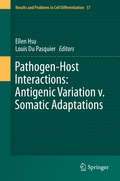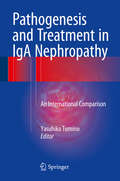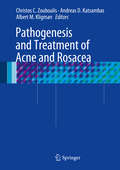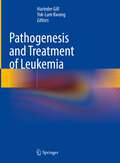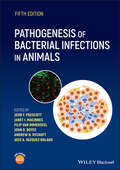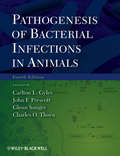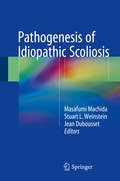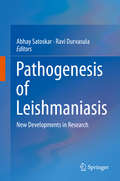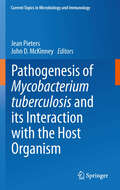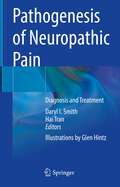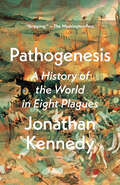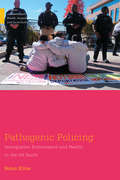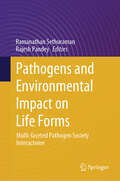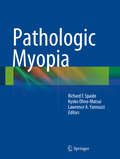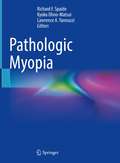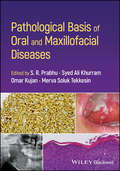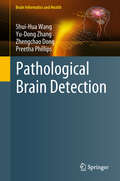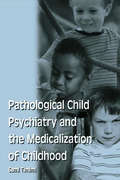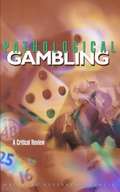- Table View
- List View
Pathogen-Host Interactions: Antigenic Variation v. Somatic Adaptations
by Ellen Hsu Louis Du PasquierThis volume provides in-depth reviews of model systems that exemplify the arms race in host-pathogen interactions. Somatic adaptations are responsible for the individualization of biological responses to the environment, and the continual struggle between host immune systems and invading pathogens has given rise to corresponding processes that produce molecular variation. Whether in mollusks or human beings, various host somatic mechanisms have evolved independently, providing responses to counter rapidly-changing pathogens. The pathways they utilize can include non-heritable changes involving RNA and post-translational modifications, or changes that produce somatic DNA recombination and mutation. For infectious organisms such as protozoans and flatworms, antigenic variation is central to their survival strategy. Evolving the ability to evade the host immune system not only increases their chances of survival but is also necessary for successful re-infection within the host population.
Pathogenesis and Treatment in IgA Nephropathy
by Yasuhiko TominoThis book discusses the latest findings on the pathogenesis and treatment of IgA nephropathy. It particularly focuses on recently recognized initiation and progression factors and the varying treatment strategies in different regions, such as Asia, Europe, and the United States. More than 40 years have passed since Dr. Jean Berger first described primary IgA nephropathy ("Nephropathy with mesangial IgA-IgG deposits") as a new disease entity. Immunohistopathologically, IgA nephropathy is characterized by the granular deposition of IgA (IgA1) and C3 in the glomerular mesangial areas with mesangial cell proliferation and the expansion of mesangial matrices. It is clear that IgA nephropathy is one of the most common types of chronic glomerulonephritis in the world. This disease may lead to end-stage kidney disease, with its enormous economic impact on healthcare everywhere. Efforts by many investigators around the world have gradually clarified various aspects of the pathogenesis and treatment of IgA nephropathy. However, there are many controversial strategies for the treatment of patients with IgA nephropathy throughout the world, as there are several limitations for treatment in each country. This volume provides nephrologists everywhere with an overview and comparison of both global and regional findings in basic and clinical fields in IgA nephropathy. It covers genetic variation, aberrant IgA1 production, and classification etiology, guidelines, and treatment goals, with all chapters written by top international researchers.
Pathogenesis and Treatment of Acne and Rosacea
by Christos C. Zouboulis Andreas D. Katsambas Albert M. KligmanThis book, written by experts from across the world, provides comprehensive coverage of acne and rosacea, focusing in particular on pathogenesis and treatment but also considering clinical aspects, prognostic factors, and impacts on quality of life. Both standard knowledge and important, clinically relevant insights that have emerged over the past decade are presented with the goal of assisting the reader in understanding these diseases and improving treatment outcome. It is explained how high-level research has recently given rise to a variety of new concepts in etiology and treatment, and emerging trends are also discussed. The book is in a reader-friendly format that highlights core messages with a very practical and clinical focus. Pathogenesis and Treatment of Acne and Rosacea will be an indispensable reference for all physicians who care for patients with acne or rosacea and for scientists working in the field.
Pathogenesis and Treatment of Leukemia
by Harinder Gill Yok-Lam KwongThis book covers a comprehensive update on acute and chronic leukemia. In 54 chapters, authors introduce research progress and clinical trials of acute myeloid leukaemia (AML), acute promyelocytic leukaemia (APL), acute lymphoblastic leukaemia (ALL), myelodysplastic syndrome (MDS), myeloproliferative neoplasm (MPN) and chronic myeloid leukemia (CML). The last decade has seen the integration of genetic and clinical information to determine the prognosis and treatment strategies. This book provides practitioners, researchers and graduate students of Hematology and Hematopathology a comprehensive update on the pathobiology, genomics, classification, diagnosis, monitoring, prognostication and therapy of both acute and chronic leukemias.
Pathogenesis of Bacterial Infections in Animals
by John F. Prescott Filip Van Immerseel Janet I. MacInnes Andrew N. Rycroft John D. Boyce José A. Vázquez-BolandPATHOGENESIS OF BACTERIAL INFECTIONS IN ANIMALS Comprehensive review of the major bacterial pathogens of animals, focusing on the current understanding of how they cause disease Pathogenesis of Bacterial Infections in Animals, Fifth Edition is a specialist reference that provides a comprehensive review of bacterial pathogens in animals and their complex interplay with disease processes, offering a complete understanding of how bacteria cause disease in animals. It covers the many recent advances in the field including the newest taxonomies. In this revised and long anticipated fifth edition, additional introductory chapters have been added to set the material in context, and more figures added to integrate and improve understanding and comprehension throughout the text. A companion website presents the figures from the book in PowerPoint and references. This detailed reference includes novel approaches to controlling bacterial pathogens in the light of growing concerns about antimicrobial resistance, with more than 70 expert authors sharing their wisdom on the topic. While molecular pathogenesis is a major aspect in almost every chapter, the authors have been careful to place pathogens in their broader context. Pathogenesis of Bacterial Infections in Animals, Fifth Edition also contains information on: Themes in bacterial pathogenesis, covering the basic elements of pathogenesis, concepts of virulence, host-pathogen interactions and communication, and pathogenesis in the post-genomic era Evolution of bacterial pathogens, covering what they are and how they emerge, along with sources of genetic diversity, population structure, and genome plasticity Understanding of pathogenesis through pathogenomics and bioinformatics, including how mutations generate pathogen diversity, and an overview of genome sequencing technologies Subversion of the immune response by bacterial pathogens, covering subversion of both innate responses and adaptive immunity Pathogenesis of Bacterial Infections in Animals, Fifth Edition is an essential resource for graduate students in veterinary medicine and animal science, and for veterinary microbiologists, pathologists, infectious disease experts, and others interested in bacterial disease. It is the only book to cover this topic to this depth through the wealth of insight of dozens of qualified and practicing professionals.
Pathogenesis of Bacterial Infections in Animals
by L. GylesPathogenesis of Bacterial Infections in Animals, Fourth Edition captures the rapid developments in understanding the mechanisms of virulence of the major bacterial pathogens of animals. Now including a color plate section, the book presents an overview of pathogenesis, including relevant events that occur in the herd or flock and its environment, and activities that take place at the cellular and molecular levels. With contributions from 64 experts in the field, this book serves as a great reference for graduate students in veterinary medicine and animal science, microbiologists, virologists and pathologists.
Pathogenesis of Idiopathic Scoliosis
by Masafumi Machida Stuart L. Weinstein Jean DuboussetThis book provides comprehensive coverage of current topics in idiopathic scoliosis (IS). A three-dimensional deformity of the spine, the condition is characterized by lateral curvature combined with vertebral rotation. The primary lesion, however, lies in the median sagittal plane, taking the form of a lordosis. Although the clinical manifestations of scoliosis have been well documented, its cause and pathogenesis have not yet been determined. Research into what causes IS has focused on the structural elements of the spine, spinal musculature, collagenous structures, the endocrine system, the central nervous system, and genetics. Results of these studies have brought about a new perception of IS epiphenomena, but the main cause of IS remains unknown. Recently, several investigators have produced new hypotheses regarding the cause of IS using the developing techniques of genetics, biochemistry, and neurology. This book is a review of the various causative factors thus far proposed for IS and an introduction to the directions in which research is heading to determine the primary cause of IS.
Pathogenesis of Leishmaniasis
by Ravi Durvasula Abhay SatoskarThis book discusses recent developments in several laboratories studying leishmaniasis. Sequencing of the human genome, as well as of the leishmania genome, has led to significant advances in our understanding of host-immune responses against leishmania, and mechanisms of infection-induced pathology, which is responsible for morbidity and mortality. Pathogenesis of Leishmaniasis focuses on the latest basic research into leishmaniasis, but also addresses how advances in understanding can be applied to prevention, control and treatment of what the WHO has classified a neglected tropical disease.
Pathogenesis of Mycobacterium tuberculosis and its Interaction with the Host Organism
by Jean Pieters John D. MckinneyMycobacterium tuberculosis is one of the most notorious pathogens on earth, causing the death of approximately 1. 5 million people annually. A major problem in the fight against tuberculosis is the emergence of strains that have acquired resistance to all available antibiotics. One key to the success of M. tuberculosis as a pathogen is its ability to circumvent host immune responses at different levels. This is not only a result of the special makeup of M. tuberculosis in terms of genetic diversity and DNA metabolism and its possession of specialized secretion systems, but also of its ability to hijack the host's innate immune defence mechanisms. In this volume, researchers from different disciplines provide a topical overview of the diverse mechanisms that contribute to the virulence of M. tuberculosis, ranging from their genetic, metabolic and molecular makeup, as well as the complex strategies these bacteria utilize to escape immune destruction within infected hosts.
Pathogenesis of Neuropathic Pain: Diagnosis and Treatment
by Daryl I. Smith Hai TranThis comprehensive source on the pathogenic origins of neuropathic pain covers the detailed molecular bases of the currently known neuropathies as classified by their pathogenic origins.Filling a critical need, this book fills the need for a resource on a syndrome that demands improved understanding by clinicians and researchers alike so that treatment options for patients are not categorically limited to a pill or a needle. If the clinician understands the origins of a patients' neuropathic pain, they can work cooperatively toward improving it with tailored therapies that don't create societal diseconomies and that ultimately are effective in helping patients.The book presents in detail the molecular bases of some currently known neuropathies by their pathogenetic origins, allowing clinicians to tailor more specific and more effective treatment regimens for their patients. For basic researchers, this book is a general resource to better direct research on neuropathy-specific molecular mechanisms. The improved understanding of the pathogenesis of neuropathic pain can then be used to develop more specific and more effective manipulations of these pathways.
Pathogenesis of Systemic Lupus Erythematosus: Insights from Translational Research
by Alberta HoiThe scope of this contributed volume is to provide an overview of the latest translational research in the field of lupus pathogenesis, with particular emphasis on how these discoveries progress in parallel with therapeutic drug development. Systemic lupus erythematosus (SLE) is a multifaceted disease with a number of well-defined immune pathways that are dysregulated, resulting in an immune-mediated chronic inflammatory injury at target organs. As knowledge of these pathways evolves to provide opportunities for targeted drug therapy and lays the foundation for personalized medicine, clinicians and researchers need to keep up with the ever-expanding medical literature.This book will critically appraise the current understanding of important immunological pathways that contribute to the pathogenesis of lupus. We will review the role of interferons as part of the innate immune defects that perpetuate the loss of self-tolerance in SLE. B cell hyperactivity, as a defining hallmark of SLE, and different strategies of B cell targeted therapy will be discussed. The role of co-stimulation or immune checkpoint molecules in activating B and T cells will be reviewed, as well as other cytokines that serve in the amplification loop promoting a more proinflammatory Th1 or Th17 responses. Intracellular targets, such as signaling molecules in the JAK/STAT pathway, or a variety of kinases and proteasomes, can cause a cascading downstream effect of transcriptional responses that are important in SLE. Immune homeostasis can also be restored by bolstering the naturally occurring anti-inflammatory mechanisms. Glucocorticoid, as a potent natural anti-inflammatory hormone, can mediate its effects by recruiting histone deacetylase that serve to repress gene transcription. Glucocorticoid-induced leucine zipper is a gene upregulated by glucocorticoid that can be a potential target for development of anti-inflammatory strategy. Finally, T regulatory cells can be utilized to help restore to immune tolerance and are amongst the latest focus of therapeutic development in SLE.
Pathogenesis: A History of the World in Eight Plagues
by Jonathan KennedyA sweeping examination of how germs have played a starring role in the most significant transformations in history, from the rise of Homo sapiens to the creation of world religions and the birth of capitalism. According to the accepted narrative of progress, humans have thrived thanks to their brains and brawn, to actions undertaken individually and collectively that have changed the arc of history. In this revelatory book, sociologist and public health professor Jonathan Kennedy argues that the peddlers of the exceptionalism myth massively overestimate the role that reason plays in social change. Instead, it is the humble microbe that wins wars and topples empires. Drawing on the latest research in genetics, economics, sociology, and anthropology, Pathogenesis explores eight outbreaks of infectious disease that made the modern world. Take the rise of Christianity. When a wave of deadly pandemics swept through the Roman Empire in the third century, there were only a small number of Christian communities—but they did a much better job tending to the sick. Their more communal approach saved thousands of lives, and helped turn this tiny, obscure sect into one of the world's great religions. Bacteria and viruses were also responsible for the demise of the Neanderthals, the growth of Islam, the transition from feudalism to capitalism, the devastation wrought by European colonialism, and the rise of the United States from an imperial backwater to a global superpower. By centering disease in his wide-ranging, spectacularly illustrated history of humankind, Kennedy challenges our most fundamental assumptions about our collective past—and urges us to view our current moment as another disease-driven inflection point that could change the course of history. Provocative and brimming with insight, Pathogenesis transforms our understanding of the human story.
Pathogenesis: A History of the World in Eight Plagues
by Jonathan KennedyA sweeping look at how the major transformations in history—from the rise of Homo sapiens to the birth of capitalism—have been shaped not by humans but by germs&“I love this surprising, learned, fascinating book; it brings human arrogance into sharp relief, reminding us that the real masters of the universe are microbes.&”—Cal Flyn, author of Islands of AbandonmentONE OF THE MOST ANTICIPATED BOOKS OF 2023: The Washington Post, Lit HubAccording to the accepted narrative of progress, humans have thrived thanks to their brains and brawn, collectively bending the arc of history. But in this revelatory book, Professor Jonathan Kennedy argues that the myth of human exceptionalism overstates the role that we play in social and political change. Instead, it is the humble microbe that wins wars and topples empires.Drawing on the latest research in fields ranging from genetics and anthropology to archaeology and economics, Pathogenesis takes us through sixty thousand years of history, exploring eight major outbreaks of infectious disease that have made the modern world. Bacteria and viruses were protagonists in the demise of the Neanderthals, the growth of Islam, the transition from feudalism to capitalism, the devastation wrought by European colonialism, and the evolution of the United States from an imperial backwater to a global superpower. Even Christianity rose to prominence in the wake of a series of deadly pandemics that swept through the Roman Empire in the second and third centuries: Caring for the sick turned what was a tiny sect into one of the world&’s major religions.By placing disease at the center of his wide-ranging history of humankind, Kennedy challenges some of the most fundamental assumptions about our collective past—and urges us to view this moment as another disease-driven inflection point that will change the course of history. Provocative and brimming with insight, Pathogenesis transforms our understanding of the human story.
Pathogenic Policing: Immigration Enforcement and Health in the U.S. South (Medical Anthropology)
by Nolan KlineThe relationship between undocumented immigrants and law enforcement officials continues to be a politically contentious topic in the United States. Nolan Kline focuses on the hidden, health-related impacts of immigrant policing to examine the role of policy in shaping health inequality in the U.S., and responds to fundamental questions regarding biopolitics, especially how policy can reinforce ‘race’ as a vehicle of social division. He argues that immigration enforcement policy results in a shadow medical system, shapes immigrants’ health and interpersonal relationships, and has health-related impacts that extend beyond immigrants to affect health providers, immigrant rights groups, hospitals, and the overall health system. Pathogenic Policing follows current immigrant policing regimes in Georgia and contextualizes contemporary legislation and law enforcement practices against a backdrop of historical forms of political exclusion from health and social services for all undocumented immigrants in the U.S. For anyone concerned about the health of the most vulnerable among us, and those who interact with the overall health safety net, this will be an eye-opening read.
Pathogenic Yersinia: Methods and Protocols (Methods in Molecular Biology #2010)
by Viveka Vadyvaloo Matthew B. LawrenzThis volume delivers a compendium of detailed protocols to the research community in order to aid in the investigation and discovery of Yersinia virulence mechanisms using important in vivo and in vitro infection models, which have led to major advances in the field and in our understanding of Yersinia pathogen-host interactions. Beginning with a section on mouse models, the book continues with chapters covering the monitoring of bacteria during infection, invertebrate models, as well as Yersinia interaction with immune cells and immune signaling. Written for the highly successful Methods in Molecular Biology series, chapters include introductions to their respective topics, lists of the necessary materials and reagents, step-by-step, readily reproducible protocols, and tips on troubleshooting and avoiding known pitfalls. Comprehensive and authoritative, Pathogenic Yersinia: Methods and Protocols provides a single source for researchers seeking to better understand these pathogens and the diseases they produce in humans.
Pathogenicity and Drug Resistance of Human Pathogens: Mechanisms and Novel Approaches
by Saif Hameed Zeeshan FatimaThe book comprehensively discusses the mechanisms of pathogenesis and drug resistance; current diagnostics landscape of four key human pathogens; bacterial, fungal, protozoans and viral which are the causes of major infectious diseases. It also assesses the emerging technologies for the detection and quantification of these pathogens. Further, it discusses the novel opportunities to fight against these infectious diseases and to identify pertinent drug targets with novel methodologies. It also reviews the current and future insights into the control, elimination, and eradication of these infectious diseases. Importantly, the book discusses the epidemiological characteristics and various challenges in combating Ebola and Influenza diseases. Finally, the book highlights the growing role of nanotechnology and bioinformatics resources for combating the infectious diseases. In summary, the book provides the mechanistic insight of the pathogenicity, drug-resistance, therapeutic strategies and identification of the novel drug targets of Mycobacterium tuberculosis, Plasmodium, Candida, Hepatitis C and emerging viral infections.
Pathogens Associated with the Development of Cancer in Humans: OMICs, Immunological, and Pathophysiological Studies
by Noé Velázquez-Márquez Genaro Alberto Paredes-Juárez Verónica Vallejo-RuizThis book examines the relationship between the different infectious agents, such as viruses, bacteria, protozoa, and fungi, in the development of cancer. It is divided into six sections, spanning a range of topics, including infectious agents, main bacterial agents, and eukaryotic microorganisms, and how they contribute to cancer. Chapters also explore the anti-tumor effect of microorganisms, how pathogens induce epigenetic changes that are associated with cancer, and nutritional management for the prevention and treatment of pathogen-associated cancer, from a nutrigenomics perspective. The studies included cover epidemiological and immunological data, different OMICs data in general, and data of pathogens associated with cancer. The book is rounded out with an analysis of the role of glycans and molecular evolution in the progression of cancer.
Pathogens and Environmental Impact on Life Forms: Multi-faceted Pathogen Society Interactome
by Rajesh Pandey Ramanathan SethuramanThis book underscores the effects of anthropogenic changes on microbes external to us and the consequences of the resultant environmental dysbiosis for our continued health and well-being. Since before the time of our last common ancestor, microbes have been shaping our evolution and our environment, just as we have shaped theirs. This fact has recently gained renewed prominence with wider acknowledgement of the microbiome (part of One Health) and its role in maintenance of human homeostasis. This two-part book titled “Pathogens and Environmental Impact on Life Forms” highlights the fluid dynamics we share with the microbes within us, including both, arguably ‘helpful’ species, and undoubtedly pathogenic ones (pathogen containment, clearance, and optimisation are dwelt on). Prominent examples include indiscriminate industrialisation and urbanisation. Both of these forces, empowered by a culture of consumerism, have led to excessive pollution and several detrimental lifestyle changes, which have culminated in our present obesity crisis and diabetes ‘pandemic’. Finally, this book concludes by emphasising that the way forward for healthcare is not only to be cognizant of the eubiotic microbiome in its diagnoses and treatments, but also to use this tremendous resource to contend with the quickly transforming landscape of infectious diseases.
Pathogens and Environmental Impact on Life Forms: Understanding Pathogens and Host Defence Mechanisms
by Rajesh Pandey Ramanathan SethuramanSince before the time of our last common ancestor, microbes have been shaping our evolution and our environment, just as we have shaped theirs. This fact has recently gained renewed prominence with wider acknowledgement of the microbiome (part of One Health) and its role in maintenance of human homeostasis. This two-part book titled “Pathogens and Environmental Impact on Life Forms”, highlights the fluid dynamics we share with the microbes within us, including both, arguably ‘helpful’ species, and undoubtedly pathogenic ones (pathogen containment, clearance, and optimisation are dwelt on).It also underscores the effects of anthropogenic changes on microbes external to us, and the consequences of the resultant environmental dysbiosis for our continued health and well-being. Prominent examples include indiscriminate industrialisation and urbanisation. Both of these forces, empowered by a culture of consumerism, have led to excessive pollution and several detrimental lifestyle changes, which have culminated in our present obesity crisis and diabetes ‘pandemic’. Finally, this book concludes by emphasising that the way forward for healthcare is not only to be cognizant of the eubiotic microbiome in its diagnoses and treatments, but also to use this tremendous resource to contend with the quickly transforming landscape of infectious diseases.
Pathologic Myopia
by Richard F. Spaide Kyoko Ohno-Matsui Lawrence A. YannuzziPathological Myopia is a major cause of severe vision loss worldwide. The mechanisms for vision loss include cataract, glaucoma, retinal detachment, and above all, degeneration of the macula within the posterior staphyloma. Pathological Myopia is one of the only current books to specifically address this disease and discusses recent developments in imaging technologies and various approaches to treatments, such as laser photocoagulation, photodynamic therapy, pharmaco-therapeutic injections in the vitreous, and surgery. Complete with high-quality color images, this book is written and edited by leaders in the field and is geared towards ophthalmologists, including residents and fellows in training, glaucoma and cataract specialists, and vitreoretinal macula experts.
Pathologic Myopia
by Richard F. Spaide Kyoko Ohno-Matsui Lawrence A. YannuzziPathologic Myopia is a major cause of severe vision loss worldwide. The mechanisms for vision loss include cataract, glaucoma, retinal detachment, and above all, myopic maculopathy within the posterior staphyloma. The first edition of Pathologic Myopia is one of the only current books to specifically address this disease and discusses recent developments in imaging technologies and various approaches to treatments, such as laser photocoagulation, photodynamic therapy, pharmaco-therapeutic injections in the vitreous, and surgery. This new edition is a timely update to the standard reference in the field, with new chapters on advanced refractive error correction, genetics, developing a classification system, and special surgical approaches for pathologic myopia. Complete with even more high-quality color images and informative tables, this book is written and edited by leaders in the field and is geared towards ophthalmologists, including residents and fellows in training, glaucoma and cataract specialists, and vitreoretinal macula experts.
Pathological Basis of Oral and Maxillofacial Diseases
by S. R. Prabhu Syed Ali Khurram Omar Kujan Merva Soluk TekkesinA comprehensive guide for integrating pathology into a clinical setting. Pathological Basis of Oral and Maxillofacial Diseases presents the basic principles involved in disease mechanisms in an easy-to-understand way. By integrating recent advances in molecular, immunologic, and genetic understanding of oral disease, the book helps readers enhance their knowledge and its application in a clinical setting. This book is divided into nine sections, covering key topics such as inflammation, genetic diseases, and neoplasia, with contributions from over 50 international authors. Diagrams, clinical, radiographic, and histopathology images and tables supplement the text, and the editors have ensured a consistent approach throughout. Topics covered in Pathological Basis of Oral and Maxillofacial Diseases include: The influences of nutrition and the environmentCellular structure and function, causes and mechanisms of cellular pathology.Immunity and host defence mechanisms, immune dysfunctions affecting the oro-facial complex.Inflammation and inflammatory diseases of the oro-facial complex Human microbiome, with reference to dysbiosis in dental caries and periodontal diseasesOral manifestations of systemic diseases and the oral-systemic link and its impact on general and oral health Oral potentially malignant and malignant disorders that are a major threat to global public health. Bridging the gap in dental training programs from basic medical science in the initial years to clinical practice, Pathological Basis of Oral and Maxillofacial Diseases is an essential reference for dental students, trainees and practitioners seeking to grasp the pathological basis of disease and apply that knowledge to the oral and maxillofacial regions.
Pathological Brain Detection (Brain Informatics and Health)
by Shui-Hua Wang Yu-Dong Zhang Zhengchao Dong Preetha PhillipsThis book provides detailed practical guidelines on how to develop an efficient pathological brain detection system, reflecting the latest advances in the computer-aided diagnosis of structural magnetic resonance brain images. Matlab codes are provided for most of the functions described. In addition, the book equips readers to easily develop the pathological brain detection system further on their own and apply the technologies to other research fields, such as Alzheimer’s detection, multiple sclerosis detection, etc.
Pathological Child Psychiatry and the Medicalization of Childhood
by Sami TimimiCurrently, it is common practice among the child psychiatric establishment to prescribe powerful and potentially addictive drugs to children who have emotional or behavioural problems. Pathological Child Psychiatry and the Medicalization of Childhood is a strong challenge to this way of thinking.Sami Timimi uses a wide variety of sources that shape our understanding including his personal experiences to highlight the role of culture, beliefs, science, social hierarchy and power, in shaping our understanding of childhood problems and how to deal with them. He urges professionals who work with children to question their assumptions in a manner that will enable them to access a greater variety of potentially helpful therapeutic frameworks.Since the 1960s, psychiatry has had to learn to accommodate critical analysis of its beliefs and methods. The legitimacy of its core assumptions continues to be questioned. Now child psychiatry too must engage with such a debate, if it wishes to develop into a genuinely democratic and inclusive profession. Pathological Child Psychiatry and the Medicalization of Childhood will be of great interest to professionals and trainees in psychiatry and child psychiatry, social work, family therapy and other psychotherapies for children and adolescents.
Pathological Gambling: A Critical Review
by National Research CouncilAs states have moved from merely tolerating gambling to running their own games, as communities have increasingly turned to gambling for an economic boost, important questions arise. Has the new age of gambling increased the proportion of pathological or problem gamblers in the U.S. population? Where is the threshold between "social betting" and pathology? Is there a real threat to our families, communities, and the larger society? Pathological Gambling explores America's experience of gambling, examining: The diverse and frequently controversial issues surrounding the definition of pathological gambling.Its co-occurrence with disorders such as alcoholism, drug abuse, and depression.Its social characteristics and economic consequences, both good and bad, for communities.The role of video gaming, Internet gambling, and other technologies in the development of gambling problems.Treatment approaches and their effectiveness, from Gambler's Anonymous to cognitive therapy to pharmacology. This book provides the most up-to-date information available on the prevalence of pathological and problem gambling in the United States, including a look at populations that may have a particular vulnerability to gambling: women, adolescents, and minority populations. Its describes the effects of problem gambling on families, friendships, employment, finances, and propensity to crime.How do pathological gamblers perceive and misperceive randomness and chance? What are the causal pathways to pathological gambling? What do genetics, brain imaging, and other studies tell us about the biology of gambling? Is there a bit of sensation-seeking in all of us? Who needs treatment? What do we know about the effectiveness of different policies for dealing with pathological gambling? The book reviews the available facts and frames the intriguing questions yet to be answered.Pathological Gambling will be the odds-on favorite for anyone interested in gambling in America: policymakers, public officials, economics and social researchers, treatment professionals, and concerned gamblers and their families.
